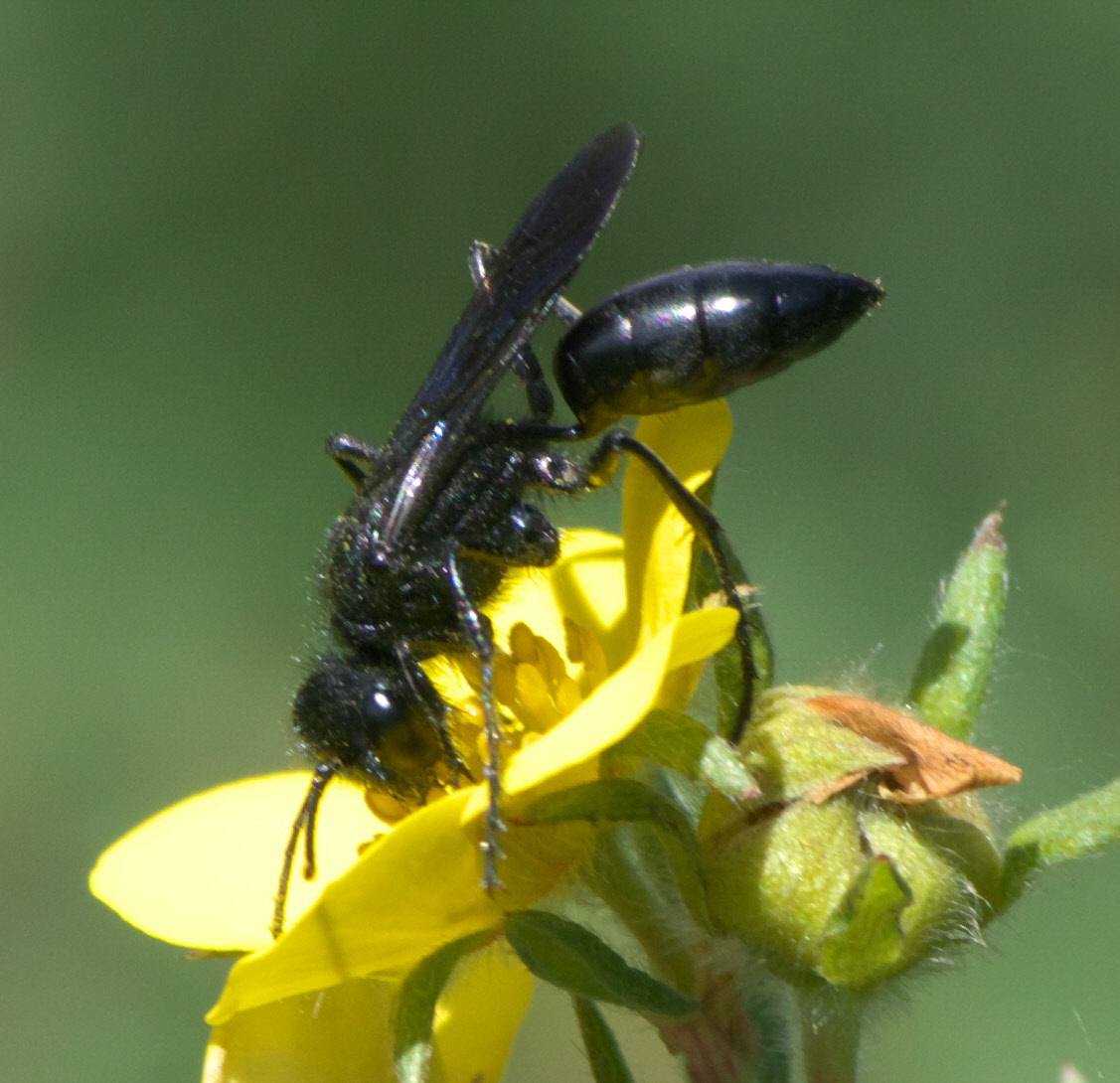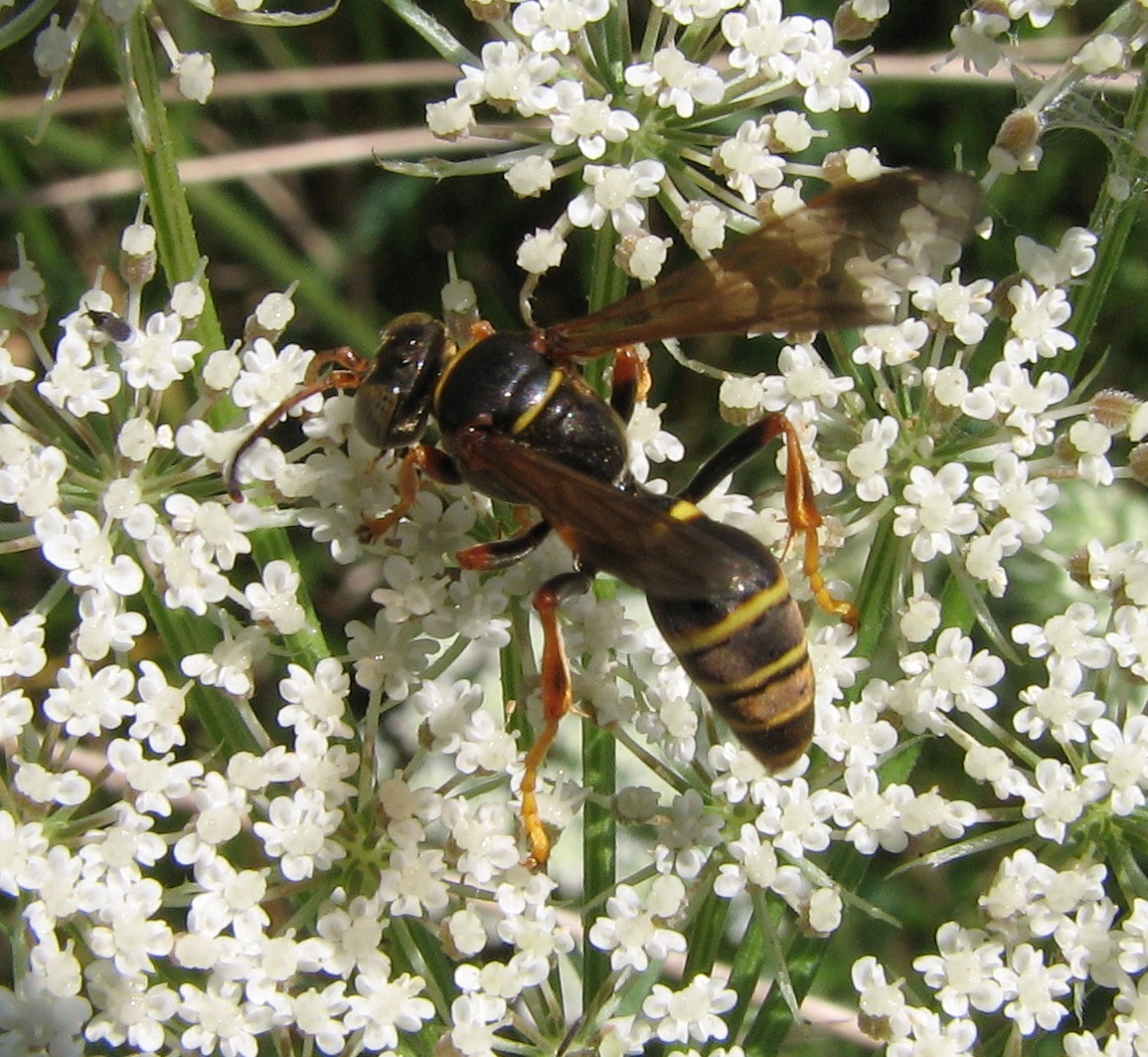|
Sphecini
The Sphecidae are a cosmopolitan family of wasps of the suborder Apocrita that includes sand wasps, mud daubers, and other thread-waisted wasps. The name Sphecidae was formerly given to a much larger grouping of wasps. This was found to be paraphyletic, so most of the old subfamilies have been moved to the Crabronidae. Biology The biology of the Sphecidae, even under the restricted definition, is still fairly diverse; some sceliphrines even display rudimentary forms of sociality, and some sphecines rear multiple larvae in a single large brood cell. Many nest in pre-existing cavities, or dig simple burrows in the soil, but some species construct free-standing nests of mud and even (in one genus) resin. All are predatory and parasitoidal, but the type of prey ranges from spiders to various dictyopterans, orthopteroids and larvae of either Lepidoptera or other Hymenoptera; the vast majority practice mass provisioning, providing all the prey items prior to laying the egg. Phylo ... [...More Info...] [...Related Items...] OR: [Wikipedia] [Google] [Baidu] |
Mass Provisioning
Mass provisioning is a form of parental investment in which an adult insect, most commonly a hymenopteran such as a bee or wasp, stocks all the food for each of her offspring in a small chamber (a "cell") before she lays the egg. This behavior is common in both solitary and eusocial bees, though essentially absent in eusocial wasps. Diversity In bees, stored provisions typically consist of masses of mixed pollen and nectar, though a few species store floral oils. In a few cases, such as stingless bees and some sweat bees, the number of cells in a single nest can number in the hundreds to thousands, but more typically a nest contains either a single cell, or a small number (fewer than 10). In predatory wasps, the food is typically in the form of paralyzed or dead prey items; after digging the nest they quickly catch one or a few prey animals, bring them to the nest and lay eggs on them, seal the nest and leave. Some wasp lineages (e.g. Crabronidae) show variation, with some spe ... [...More Info...] [...Related Items...] OR: [Wikipedia] [Google] [Baidu] |
Isodontia Larva
''Isodontia'' is a genus belonging to the family Sphecidae. Adults emerge from their cocoons in early summer, and usually make nests lined with grass or hay in hollow plant cavities. This has led to their common name being grass-carrying wasps. The larvae are often fed Orthoptera that the adult has paralyzed. Species Species within this genus include: * ''Isodontia albata'' * ''Isodontia alvarengai'' * '' Isodontia apicalis'' * ''Isodontia apicata'' * ''Isodontia aurifrons'' * '' Isodontia auripes'' * '' Isodontia auripygata'' * ''Isodontia azteca'' * '' Isodontia bastiniana'' * ''Isodontia boninensis'' * '' Isodontia bruneri'' * '' Isodontia capillata'' * '' Isodontia cellicula'' * '' Isodontia cestra'' * '' Isodontia chrysorrhoea'' * '' Isodontia costipennis'' * '' Isodontia cyanipennis'' * '' Isodontia delicata'' * '' Isodontia diodon'' * '' Isodontia dolosa'' * ''Isodontia edax ''Isodontia'' is a genus belonging to the family Sphecidae. Adults emerge from their coco ... [...More Info...] [...Related Items...] OR: [Wikipedia] [Google] [Baidu] |
Pierre André Latreille
Pierre André Latreille (; 29 November 1762 – 6 February 1833) was a French zoologist, specialising in arthropods. Having trained as a Roman Catholic priest before the French Revolution, Latreille was imprisoned, and only regained his freedom after recognising a rare beetle species he found in the prison, ''Necrobia ruficollis''. He published his first important work in 1796 (), and was eventually employed by the . His foresighted work on arthropod systematics and taxonomy gained him respect and accolades, including being asked to write the volume on arthropods for George Cuvier's monumental work, , the only part not by Cuvier himself. Latreille was considered the foremost entomologist of his time, and was described by one of his pupils as "the prince of entomologists". Biography Early life Pierre André Latreille was born on 29 November 1762 in the town of Brive, then in the province of Limousin, as the illegitimate child of Jean Joseph Sahuguet d'Amarzit, général ... [...More Info...] [...Related Items...] OR: [Wikipedia] [Google] [Baidu] |
Spider
Spiders ( order Araneae) are air-breathing arthropods that have eight legs, chelicerae with fangs generally able to inject venom, and spinnerets that extrude silk. They are the largest order of arachnids and rank seventh in total species diversity among all orders of organisms. Spiders are found worldwide on every continent except for Antarctica, and have become established in nearly every land habitat. , 50,356 spider species in 132 families have been recorded by taxonomists. However, there has been debate among scientists about how families should be classified, with over 20 different classifications proposed since 1900. Anatomically, spiders (as with all arachnids) differ from other arthropods in that the usual body segments are fused into two tagmata, the cephalothorax or prosoma, and the opisthosoma, or abdomen, and joined by a small, cylindrical pedicel, however, as there is currently neither paleontological nor embryological evidence that spiders ever had ... [...More Info...] [...Related Items...] OR: [Wikipedia] [Google] [Baidu] |
Bembicinae
The Bembicinae comprise a large subfamily of crabronid wasps that includes over 80 genera and over 1800 species which have a worldwide distribution. They excavate nests in the soil, frequently in sandy soils, and store insects of several orders, for example Diptera, Orthoptera, Hemiptera, Lepidoptera and Odonata Odonata is an order of flying insects that includes the dragonflies and damselflies. Members of the group first appeared during the Triassic, though members of their total group, Odonatoptera, first appeared in Late Carboniferous. The two com ... in the burrows. Some species are kleptoparasites of other Bembicinae. The different subgroups of Bembicinae are each quite distinctive, and rather well-defined, with clear morphological and behavioral differences between them. Bembicines were originally a part of a single large family, the Sphecidae, then for many years were treated as a separate family, and recently have been placed back into a larger family, the C ... [...More Info...] [...Related Items...] OR: [Wikipedia] [Google] [Baidu] |
Astatinae
Astatinae are a cosmopolitan group of solitary wasps, peculiar for their males having very large compound eyes that broadly meet at the top of the head. The largest genus in this subfamily is ''Astata ''Astata'' is a cosmopolitan genus of solitary predatory wasps in the subfamily Astatinae. They are known to prey on adults and nymphs of Pentatomidae. ''Astata'' is the largest genus in this subfamily, and is identified by features of its wing v ...'', with about half of more than 160 species in the subfamily. Phylogenomic analysis of Apoidea published in 2018 suggested that Astatinae, along with several other subfamilies and a subtribe, should be promoted to family rank: Ammoplanina (= Ammoplanidae), Astatinae (= Astatidae), Bembicinae (= Bembicidae), Mellininae (= Mellinidae), Pemphredoninae (= Pemphredonidae), Philanthinae (= Philanthidae), and Pseninae (= Psenidae). References Crabronidae Apocrita subfamilies Biological pest control wasps {{Apoidea-stub ... [...More Info...] [...Related Items...] OR: [Wikipedia] [Google] [Baidu] |
Ampulicidae
The Ampulicidae, or cockroach wasps, are a small (about 170 species), primarily tropical family of sphecoid wasps, all of which use various cockroaches as prey for their larvae. They tend to have elongated jaws, pronounced neck-like constrictions behind the head, strongly petiolate abdomens, and deep grooves on the thorax. Many are quite ant-like in appearance, though some are brilliant metallic blue, green, and hot pink. Most species sting the roach more than once and in a specific way. The first sting is directed at nerve ganglia in the cockroach's thorax, temporarily paralyzing the victim for a few minutes - more than enough time for the wasp to deliver a second sting. The second sting is directed into a region of the cockroach's brain that controls the escape reflex, among other things. Piper, Ross (2007), ''Extraordinary Animals: An Encyclopedia of Curious and Unusual Animals'', Greenwood Press. When the cockroach has recovered from the first sting, it makes no attempt to f ... [...More Info...] [...Related Items...] OR: [Wikipedia] [Google] [Baidu] |
Anthophila
Bees are winged insects closely related to wasps and ants, known for their roles in pollination and, in the case of the best-known bee species, the western honey bee, for producing honey. Bees are a monophyletic lineage within the superfamily Apoidea. They are presently considered a clade, called Anthophila. There are over 16,000 known species of bees in seven recognized biological families. Some speciesincluding honey bees, bumblebees, and stingless beeslive socially in colonies while most species (>90%)including mason bees, carpenter bees, leafcutter bees, and sweat beesare solitary. Bees are found on every continent except Antarctica, in every habitat on the planet that contains insect-pollinated flowering plants. The most common bees in the Northern Hemisphere are the Halictidae, or sweat bees, but they are small and often mistaken for wasps or flies. Bees range in size from tiny stingless bee species, whose workers are less than long, to ''Megachile pluto'', the l ... [...More Info...] [...Related Items...] OR: [Wikipedia] [Google] [Baidu] |
Phylogenomics
Phylogenomics is the intersection of the fields of evolution and genomics. The term has been used in multiple ways to refer to analysis that involves genome data and evolutionary reconstructions. It is a group of techniques within the larger fields of phylogenetics and genomics. Phylogenomics draws information by comparing entire genomes, or at least large portions of genomes. Phylogenetics compares and analyzes the sequences of single genes, or a small number of genes, as well as many other types of data. Four major areas fall under phylogenomics: * Prediction of gene function * Establishment and clarification of evolutionary relationships * Gene family evolution * Prediction and retracing lateral gene transfer. The ultimate goal of phylogenomics is to reconstruct the evolutionary history of species through their genomes. This history is usually inferred from a series of genomes by using a genome evolution model and standard statistical inference methods (e.g. Bayesian inference ... [...More Info...] [...Related Items...] OR: [Wikipedia] [Google] [Baidu] |
Phylogenetic Tree
A phylogenetic tree (also phylogeny or evolutionary tree Felsenstein J. (2004). ''Inferring Phylogenies'' Sinauer Associates: Sunderland, MA.) is a branching diagram or a tree showing the evolutionary relationships among various biological species or other entities based upon similarities and differences in their physical or genetic characteristics. All life on Earth is part of a single phylogenetic tree, indicating common ancestry. In a ''rooted'' phylogenetic tree, each node with descendants represents the inferred most recent common ancestor of those descendants, and the edge lengths in some trees may be interpreted as time estimates. Each node is called a taxonomic unit. Internal nodes are generally called hypothetical taxonomic units, as they cannot be directly observed. Trees are useful in fields of biology such as bioinformatics, systematics, and phylogenetics. ''Unrooted'' trees illustrate only the relatedness of the leaf nodes and do not require the ancestral root to b ... [...More Info...] [...Related Items...] OR: [Wikipedia] [Google] [Baidu] |





